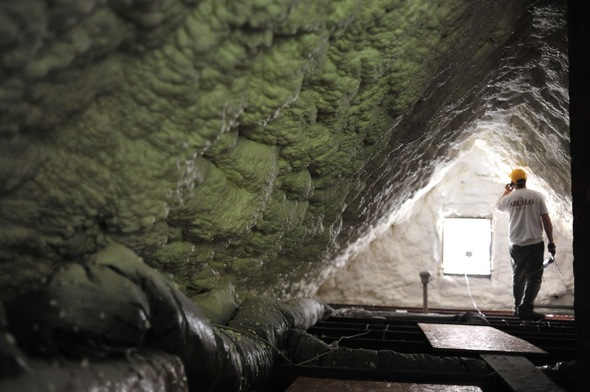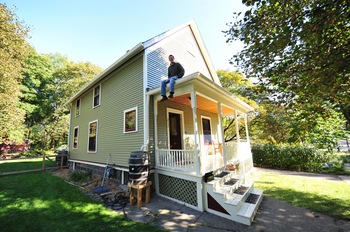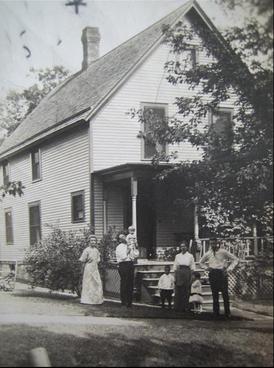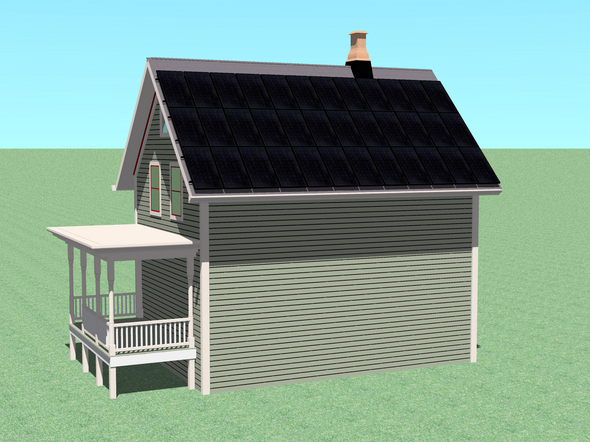Going solar: Ann Arbor man plans to make history with first 'net zero' home in a historic district

John Rioux, a contractor from Arbor Spray Foam Insulation, applies a thick foam insulation on Friday inside the attic of Matt Grocoff's house on South Seventh Street in Ann Arbor. It's part of several energy efficiency upgrades Grocoff is making to his home.
Ryan J. Stanton | AnnArbor.com
When Matt Grocoff and his wife, Kelly, bought their 110-year-old Victorian home four years ago, it came complete with asbestos, lead paint, a half-century-old furnace and no insulation.
The month before they turned on a newly installed geothermal energy system in January 2007, their monthly utility bill was $350, Grocoff recalls.
"So, we would have been paying about $2,800 a year in utilities to run our house, which is about average for an old house," he says. "Now multiply that by 20 years, that would be $56,000, assuming that utility prices stay exactly the same."
Instead of paying through the roof (literally, there was no attic insulation) over the next two decades, the founder of Greenovation.TV has been on a mission making energy efficient improvements to his home on South Seventh Street on Ann Arbor's Old West Side.

Grocoff plans to make his 110-year-old home on South Seventh Street produce more energy than it uses by installing state-of-the-art solar panels in the next month to complement other energy efficient improvements. Grocoff says his home will be the oldest 'net zero' home in the country, and the first ever in a historic district.
Ryan J. Stanton | AnnArbor.com
As a contributing writer to Old House Web, Grocoff says he has been studying green building for years. Now he's applying the principles he's learned to his own home.
In the next month, Grocoff plans to install a state-of-the-art solar panel system on the south-facing side of his roof. Once the system is up and running, the home's electric meter will begin to spin in reverse (the home actually will produce more energy than it uses) and Grocoff will start collecting money from DTE Energy for contributing electricity to the power grid.
"We would have spent $56,000. We're going to be netting $40,000 instead, which is a $96,000 swing," Grocoff says. "That'll pay for an Ivy League school for my daughter, I think."
From his own research, Grocoff believes it will be the first house in the entire nation in a historic district to be "net zero," meaning it generates 100 percent of its power from renewable sources onsite all the time. He also believes it will be the oldest house in the United States to be net zero.
"But hopefully not for long," he says. "We're hoping that as soon as people see that it's possible — not just to do it in a brand-new house, but that it can be done in a 110-year-old house on a relatively modest budget — that more people will do this."
Grocoff was able to work out financing for the geothermal system when he bought the house in 2006. He says his out-of-pocket expenses for the solar panel system will be about $14,000 after factoring in tax credits he is receiving from the federal government and from DTE Energy.
He expects to recoup his investment and begin to profit within five years.
"Over the long-term, it's a no-brainer for just about anybody with a roof that faces the sky," Grocoff says. "The only challenge is that you've got these hurdles to get over first."
Daren Griffith, sales and marketing manager for Canton-based Mechanical Energy Systems, stood side-by-side with Grocoff before the Ann Arbor Historic District Commission this month. Griffith, whose company plans to install the solar panels, helped convince the HDC to allow adding the panels to Grocoff's house, which is in the Old West Side Historic District.
"Like I told the Historic District Commission, the money savings — whether it's energy efficiency or whether it's renewable energy, or a combination thereof — really helps their cause," Griffith says. "It helps to preserve these buildings, it helps to make the community more attractive, it all adds up. And the amount of money that Matt's going to save, and the next homeowner's going to save, guess what happens to that savings? It ends up getting rolled back into the economy."

Matt and Kelly Grocoff plan to restore the historic integrity of this 1900 Victorian, shown here circa 1913 with the Gauss family that lived there.
Courtesy Photo
Grocoff has been fielding phone calls for several months from statewide and national media outlets inquiring about his home improvement project. He has chosen a set of black solar panels made by SunPower Corp. of San Jose, one of the oldest solar manufacturers in the United States. The panels will be connected to a set of high-tech Enphase Microinverters.
The way Grocoff sees it, he's making the up-front investment now to provide energy for the life of his house — and, in the future, he expects to keep an electric car charged with the energy his home is producing, further reducing his reliance on fossil fuels.
"What we're doing is proving that it's possible," he says, hopeful that owners of other older homes will follow in his footsteps in the coming years.
"It's not just something that I think will be cool for everybody to go out and get solar," he says. "It's an absolute necessity going forward. Twenty-two percent of carbon emissions in the United States come from our homes. Not from our cars, not from other buildings — from our homes. There are 130 million existing houses out there, so we've got to figure out a way to make them more efficient and make them run off of renewable energy."
Grocoff says cooperation from historic district commissions will play a big role.
"Historic houses are really inefficient," he says. "They've got old, leaky windows, and so there's a long way to go in those historic houses because they're already so inefficient. So we have to fix those. We're not going to tear them down. It would be foolish and environmentally bad judgment to tear down old houses. So we want to preserve them, and a way to do that is to make them as energy efficient as possible and then produce renewable energy onsite."

This rendering shows what the black solar panels will look like covering the south-facing side of Grocoff's roof on South Seventh Street in Ann Arbor.
Courtesy Image
Ryan J. Stanton covers government and politics for AnnArbor.com. Reach him at ryanstanton@annarbor.com or 734-623-2529.


Comments
elisheva
Tue, Sep 21, 2010 : 8:25 a.m.
foam also acts to seal the cracks so if you use fiberglass be sure to calk the cracks too my foam has been outgassing for a couple of years now.an open window does the trick foam can get where others things can't...it's a trade off and of course your comfort level my house is so well insulated that i turn the furnace on for 1 hour in the am and 1 hr at dinner time(in the middle of winter, -10 degree outside) last year my heat bill was $35 for the month of jan. i have used only 595 ccf's of natural gas --total for 4 winters--that's roughly 150 c's per winter-sept -june
Killroy
Mon, Sep 20, 2010 : 7:10 a.m.
@ peg dash fab, and you've never heard of Public Relations? Please, this would upset the balance of power (literally).
20/20
Mon, Sep 20, 2010 : 6:13 a.m.
That sprayed foam insulation makes me nervous, 10-20 years from now, will it break down and create hazardous off gases? I'm assuming it's a combination off at least two chemicals, I think I'll stick with the fiberglass insulation for now.
AlphaAlpha
Sun, Sep 19, 2010 : 9:20 p.m.
Hello elisheva - Huge congratulations on your energy accomplishments. Were more folks doers like you instead of whiners, the world would already be a better place. Spoon feeding...not necessary. This would be a good platform for you to show others it can be done, not just sought. There is great hope for the future of alternate energy sources; you may be over expecting the average citizen to make unsound energy investments -yet-; but, when solar et al is cheaper, there will be a flood of buyers. That will be a paradigm change of profound importance. Don't fret about the carbon - soon enough it will be relegated to a minor energy role. What? Yes. The linear thinkers to which you alluded do not comprehend this yet, but it's coming, and not soon enough. Perhaps, for the sake of the community, you would consider posting your own story of energy independence sometime. It sounds quite newsworthy. Good luck.
elisheva
Sun, Sep 19, 2010 : 8:19 p.m.
yeh alpha alpha everyone wants to be spoon fed....i'll sit here and you tell me how to do it....i read some books, read online, made phone calls...in essense did the work to learn what i wanted, and i put up some wind turbines and solar panels and they take care of my needs. i bought them while the money i had, still had worth. furnace without electricity is not a want or a need...it's useless.my jan. heating bill was $35 last year what was yours? what about what you spend on a car? figure out it's depreciating waste of money..a need? with buses etc no it's choices....and as i age, i would like electricity to make my needs happen...you can hope it's all the same next year...same prices same needs, same job to pay for needs the problem is that most people think what we have right now, will never ever change...i'm not sure why they think that...because it does always change. in fact quite a bit these last few years. if you can't see why it would be nice to have electricity in the future in a sustainable way....then you can not see that and you will not do now, what it takes to make sure your needs are taken care of in the future and i will have and you will not and you will keep hoping that someone else takes care of you
AlphaAlpha
Sun, Sep 19, 2010 : 8:02 p.m.
Furnace: need. Solar: want. And, enlightened consumers do compare various models to determine cost effectiveness, analogous to payback. However, that is a digression...please enlighten us as to your solar installation; whoever read this article would likely like to know of other solar installations...
elisheva
Sun, Sep 19, 2010 : 7:34 p.m.
payback times; it's the wrong question. no one asks how long it takes for their furnace to make sense. i have solar power. you do not. it's that simple i have my own power no matter what the grid does. so when the power goes out...i have power...you do not. this message is coming to you all totally from solar power. not an ounce of coal co2 in the air from this comment
AlphaAlpha
Sun, Sep 19, 2010 : 7:31 p.m.
Honored A2.com Moderators: It might be nice for you to inform key individuals when a story about them is going to be published, so that they might attempt to maintain a presence online whilst their story is warm. Some good questions were posed here today...the Grocoff's likely would have contributed quite a bit to the discussion. Just a thought...
AlphaAlpha
Sun, Sep 19, 2010 : 7:16 p.m.
Unfortunately, we are likely many years away from economically feasible solar cells. Feasible means payback in perhaps 8 years or less. No matter how passionate one wishes for widespread solar applications, with the current 20-40 year (unsubsidized) paybacks, no one with much concern for their for their personal finances (and the ability to calculate payback periods) will purchase these devices-for homes at least. Thankfully, there are various specialty applications where solar makes sense, and these applications will grow as the cost continues it's slow descent to widespread affordability. As for federal programs to enhance subsidies...dream on. It's not going to happen. If you want to make a significant difference, simply apply some caulk. Payback time: generally less than one year.
elisheva
Sun, Sep 19, 2010 : 7:06 p.m.
i have a couple more comments. putting solar panels on the roof in michigan means that someone will have to climb up there and brush the snow off..if you want electricity right away. if you are willing to let them not work for a few days, stay off the roof re the math: this dte program is using people who want to be green, pay for their infrastructure. this man is not buying his own to use solar panels...dte has a big say so on this whole deal, when and how they are to be used dte gets the credit for reaching/meeeting gov't required whatever percentage green by having unaware home owners pay for it. dte is charging way more...almost double the cost of installing this system....one can buy the components themselves and do the installation...this is not a complicated process dte is charging $9 a watt...ive done it for $3 a watt.and still get the 30% tax credit from the gov't and as i stated before, this man is using coal burning and nuclear power to use electriity in his home. dte is giving him brown energy for his green. the power coming from his solar panels is not directly running his home. i am totally for solar and wind power...but not some scam from dte and finally, geothermal doesn't work at all when the electricity goes off
Speechless
Sun, Sep 19, 2010 : 4:47 p.m.
From near the end of the article:... The way Grocoff sees it, he's making the up-front investment now to provide energy for the life of his house.... "What we're doing is proving that it's possible," he says, hopeful that owners of other older homes will follow in his footsteps in the coming years.... "It's an absolute necessity going forward. Twenty-two percent of carbon emissions... come from our homes.... There are 130 million existing houses out there, so we've got to figure out a way to make them more efficient and make them run off of renewable energy." Along with universal health care (or, alternately, Medicare for all), this represents a fine area in which to initiate a major flow of public subsidy funding. The country could retrofit a whole lot homes and buildings over time by diverting a few hundred billion a year from our roughly $660 billion annual military budget and by raising rates for high-end tax brackets. Like education costs, a full home retrofit for maximized energy conservation potential is far too expensive for most people to afford privately. So, just as funds began to be raised over a century ago to establish public education systems across the nation, the same should be done today to systematically prepare U.S. cities for the energy realities that will arrive during this century.
Macabre Sunset
Sun, Sep 19, 2010 : 4:02 p.m.
When we start personally budgeting federal subsidies, the taxpayers have lost. Of course, by the time his daughter is off to the Ivy League, the nation will be bankrupt and we'll be facing banana-republic style inflation.
Tim R. Land
Sun, Sep 19, 2010 : 2:24 p.m.
What the article fails to mention is that the HDC vote was unanimous to approve the solar panels.
SillyTree
Sun, Sep 19, 2010 : 1:13 p.m.
I wish that there were laws that mandated that apartment buildings had to use energy efficient appliances and adequate insulation. I would rather pay them more rent that to pay it to the utility companies. They have no interest in anything that is not mandated by law because it would cost them money. There is no incentive for green apartments. If I had the resources, I would start to build and/or convert apartment properties to green. I pay more for my utilities in an apartment than I did when I had a house. That isn't right consdidering that only two of the four sides are exposed to the outside. I roast in the summer and freeze in the winter. Even without laws, I think there would be a market for green apartments. I don't have the resources, but I would like to see someone get on it.
Stephen Landes
Sun, Sep 19, 2010 : 11:28 a.m.
I think it is inappropriate to reduce the investment for purposes of calculating a ROI by removing the government subsidies from the total investment. While the subsidies reduce the investment by the immediate owner of the project the subsidy money comes from somewhere -- namely from the taxes we all pay. There ain't no such thing as a free lunch. We would all be better off if the subsidy had to be repaid over the life of the project from the savings generated. That would be a more honest approach -- make the subsidies a hand-up not a hand-out.
Mark Naess
Sun, Sep 19, 2010 : 11:08 a.m.
Don't forget he already paid to put in a geo-thermal heating and cooling and (and likely water heating) system--those cost a lot. Geothermal would have reduced his need for power quite a bit, so the solar should pay back faster. But he does not mention, what the geothermal cost, or what impact it had on his energy bills. I too dream of ending up energy neutral in my old (1896, but not in a historic district) home, and powering an electic car at that. The math, though, is daunting. Maybe the home fuel cell......
peg dash fab
Sun, Sep 19, 2010 : 10:45 a.m.
Jeffery, who claims "The HDC will never approve the roof." seems to have missed this sentence: "Griffith, whose company plans to install the solar panels, helped convince the HDC to allow adding the panels to Grocoff's house, which is in the Old West Side Historic District." I have some bad news for the Grocoffs: $96,000 will buy only half of an Ivy League education.
AlphaAlpha
Sun, Sep 19, 2010 : 10:03 a.m.
Interesting. A worthy goal. Could you please comment further on the economics of this project? It's not a no brainer. What are the current (pre solar) electric bills? Sunpower's site says: "Q How much does a SunPower residential solar system cost? A In general, the cost is about $8000 - $10,000 per kilowatt (kW). So a 2500 sq. ft. home with moderate electricity usage (an electric bill of about $150 per month) could require a 4kW system. This would cost about $30,000 to $40,000 before state and federal rebates and $15,000 to $20,000 after rebates." If the average cost is $17,500 after subsidies, and a 'moderate' electric bill of $100 per month, payback requires 17,500 / 100 /12 = 15 years. The panels have a 10 year limited warranty... Will the federal subsidies expire? When they do, payback could increase to a staggering 30 years.
Killroy
Sun, Sep 19, 2010 : 9:44 a.m.
The HDC will never approve the roof. However, I think they should accept it and close the out the HDC board; useless and not ROI oriented. I'd love a tour of the place once it's completed! Bravo!
BigMike
Sun, Sep 19, 2010 : 9:06 a.m.
@xmo - I wanna know how the math works, too. Does the $14,000 capital investment figure into the $40,000 net?
xmo
Sun, Sep 19, 2010 : 8:40 a.m.
Could someone explain the math to me? "We would have spent $56,000. We're going to be netting $40,000 instead, which is a $96,000 swing So, we would have been paying about $2,800 a year in utilities to run our house, which is about average for an old house," he says. "Now multiply that by 20 years, that would be $56,000, assuming that utility prices stay exactly the same He says his out-of-pocket expenses for the solar panel system will be about $14,000 after factoring in tax credits he is receiving from the federal government and from DTE Energy
ArthGuinness
Sun, Sep 19, 2010 : 7:51 a.m.
Historic preservation groups like the HDC have *WAY* too much power. Everyone should be thankful that they actually made a good decision this time, because there's no way to protest it.
jcj
Sun, Sep 19, 2010 : 7:44 a.m.
Congratulations on a solid plan. However like most people trying to support their way of thinking. The figures are skewed to make it look more attractive than it is. It does not matter if someone is selling you a car, refrigerator, a pit bull, or green. They are going to make it look as attractive as possible. But this is a good plan for those planning on staying in their home for 10 plus years. How many people do that? Although with the current outlook for the economy people will be staying in their homes longer.
MB111
Sun, Sep 19, 2010 : 7:12 a.m.
How can the Historic District allow this? The original roof is 110 years old - clearly it must be kept in its original form, it old after all.
elisheva
Sun, Sep 19, 2010 : 6:58 a.m.
i'm glad you are willing to take publicity for this important topic.however, there are many of us quietly using solar and wind power already here in washtenaw county.and on our own...no dte if i am not mistaken, the dte program you are using will turn the solar off if the grid goes down and you will still need a back up generator while your panels sit idle. also dte will get the green energy credit and sell you brown energy to actually use. that said, it's still good to see things moving forward.
Phillip
Sun, Sep 19, 2010 : 5:34 a.m.
It had to be someone to start it and you showed me that you are that one.